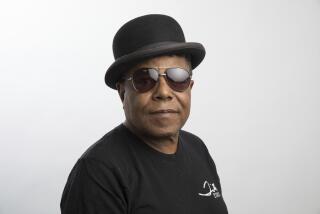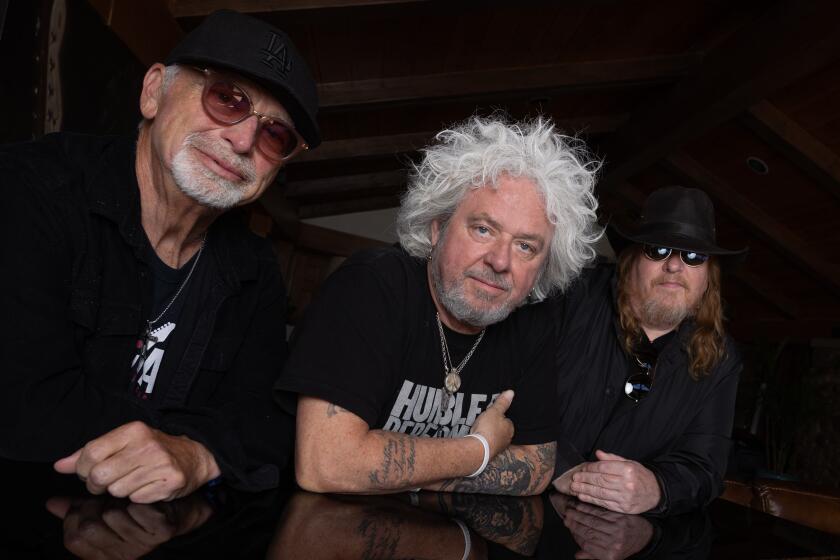‘Day to Day’s’ end severs NPR’s strongest tie to the West
Faux-Westerners tend to give themselves away. They drive with their convertible tops down on frigid winter days. They write lyrically about night air filled with the pungent smell of (scentless) bougainvillea. And, when times get tough, they revert to their Eastern roots.
National Public Radio feels like a slightly tone-deaf interloper this week, as it kills its engaging, Culver City-based magazine, “Day to Day,” and hacks its West Coast staff. This all comes just six years after the network proclaimed a deep new commitment to life on our distant shores.
I’m a big fan of NPR and its top-drawer political and cultural coverage. I don’t think the bosses are making these cuts lightly. But it’s probably hard to realize, from the banks of the Potomac, just how much many of us out here in the provinces will miss host Madeleine Brand and the rest of the “Day to Day” crew, who are due to sign off for the final time this Friday.
A librarian in Little Rock, Ark., joined scores of other listeners in e-mailing about how bereft she feels about the loss of the show and its “informative news features [with] plenty of ‘candy’ thrown in . . . interviews with famous people, funny takes on politics or current events, or just off-beat stories.”
NPR announced in December that it would cut “Day to Day” and the African American-oriented “News & Notes” to save money, as it projected corporate underwriting would drop this year from $46 million to $33 million. The cancellation of the two programs and reduction of support personnel mean the loss of 39 full-time and temporary employees at the arty, airy brick-walled NPR West studios, including Brand. Nearly 30 reporters, producers and support staff will remain at the Culver City facility, along with Renee Montagne, co-host of NPR’s blockbuster “Morning Edition.”
A fresh look
That won’t begin to fill the painful gap that will be left by the disappearance of “Day to Day,” which airs locally from 9 to 10 in the morning on KPCC-FM (89.3). After more than five years, the show had spread to nearly 200 NPR member stations. It had a way of delivering both the news you needed and the features you came to understand you wanted. If you’d grown complacent about the war in Iraq, “Day to Day” jolted you back to attention with a series featuring an idealistic young Army captain. One day, Nate Rawlings told of the aftermath of a truck bombing and finding a suicide bomber’s face “plastered to the side of a big round pole.” Another day Rawlings gained a measure of solace at being able to keep soldiers in a house raid from waking two sleeping boys.
The show devoted considerable attention to climate change, humanizing a sometimes dreary subject with a portrait of scientist Charles Keeling. Brand and producer Deborah Clark introduced us to Keeling as not just a researcher, but as a classical pianist who proved the worldwide buildup of carbon dioxide after decades in Hawaii “gathering the wind” in glass containers.
In recent days, as it prepared to go off the air, “Day to Day” replayed some of its greatest hits, including a riveting 2004 interview of Aron Ralston, the hiker who (in what former host Alex Chadwick described as a moment of “salvation and horror”) sawed off his own arm to escape from a Utah canyon where a falling boulder had pinned him.
“Day to Day” could throw haymakers like that. But the blows were softened by features like “The Unger Report,” former “Daily Show” correspondent Brian Unger’s sardonic take on subjects as diverse as Twitter and corporate rebranding.
A distinct voice
When I talked to Brand this week about the program’s demise, she expressed a mixture of resignation, sadness and anger.
“It takes awhile to find your voice and we had really found our voice and now . . . “ she said, pausing deliciously, as she does so often on air, “no more voice.”
Out poured the infectious laugh that has become one of Brand’s signatures, along with that commute-lightening voice. Whether conveying empathy, irreverence or wonder, Brand delivered a winning amalgam -- Unger calls it “journalistic sensuality.”
Brand, 43, expresses frustration that the decision-makers in Washington didn’t ask their Western comrades about alternatives, such as producing the show for less than its $2.5-million budget. Jeff Hansen, program director at KUOW in Seattle, questioned NPR’s strategy of continuing to build its Internet presence while cutting “radio production, which is what we excel in.”
Ellen Weiss, NPR’s senior vice president for news, called herself a “huge fan” of “Day to Day” and said she regrets having to make any cut. But she said the network decided against across-the-board reductions that would have weakened many programs, particularly the network’s signature “Morning Edition” and “All Things Considered.”
With NPR’s remaining stable of eight reporters in Culver City and correspondents in places including Tucson and Denver, Weiss argued that the network maintains a strong Western presence. She called the fact Montagne continues to co-host “Morning Edition” from NPR West “the biggest statement we can make to being a national program.”
It seems to me the biggest statement about a commitment to the West would have been to keep nurturing “Day to Day.” Now, the best hope for salvaging the program is in local hands, as Southern California Public Radio President Bill Davis has gone hunting for benefactors to air a sort of “ ‘Daughter of Day to Day.’ ” Davis, who runs KPCC, figures he would need $500,000 a year for two years.
That seems like a small price to pay for a voice that was as unpredictable and distinctive as the West.
--
More to Read
The biggest entertainment stories
Get our big stories about Hollywood, film, television, music, arts, culture and more right in your inbox as soon as they publish.
You may occasionally receive promotional content from the Los Angeles Times.











